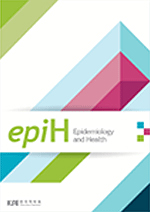Folate, vitamin B12, and homocysteine status in the Korean population: data from the 2013-2015 Korea National Health and Nutrition Examination Survey
Folate, vitamin B12, and homocysteine status in the Korean population: data from the 2013-2015 Korea National Health and Nutrition Examination Survey
- 한국역학회
- Epidemiology and Health
- 46
-
2024.011 - 10 (10 pages)
-
DOI : 10.4178/epih.e2024007
- 5

OBJECTIVES: We aimed to assess the serum folate, vitamin B12, and homocysteine status in Korean adolescents and adults using national data. METHODS: Blood samples were collected from participants aged ≥10 years in the Korea National Health and Nutrition Examination Survey 2013-2015. The stored serum samples were used to measure folate, vitamin B12, and homocysteine concentrations. A total of 8,016 participants were included in this analysis. Unweighted descriptive statistics and adjusted geometric means of the B vitamins and homocysteine concentrations were estimated. RESULTS: Females had higher serum folate and vitamin B12 concentrations and lower serum homocysteine concentrations than males. Folate deficiency (<6.8 nmol/L) and hyperhomocysteinemia (>15 μmol/L) were found in 8.6% and 11.8% of males, respectively. Approximately 3% of males had low or marginally low vitamin B12 status (≤221 pmol/L). Folate and vitamin B12 deficiencies and hyperhomocysteinemia were found in <2% of females. Suboptimal folate status was prevalent among adolescents and young adults, while suboptimal vitamin B12 status and hyperhomocysteinemia were relatively higher in older adults. Adjusted mean homocysteine concentrations were sharply decreased from the first to second decile of serum folate in males. CONCLUSIONS: In the Korean population, the proportion of males who achieved desirable folate and homocysteine concentrations were lower than those of females. Although most Koreans have adequate vitamin B12, a suboptimal folate status is common, particularly among adolescents and young adults. These findings could establish a foundation for public health initiatives aimed at improving folate levels in the Korean population.
INTRODUCTION
MATERIALS AND METHODS
RESULTS
DISCUSSION
NOTES
REFERENCES
(0)
(0)